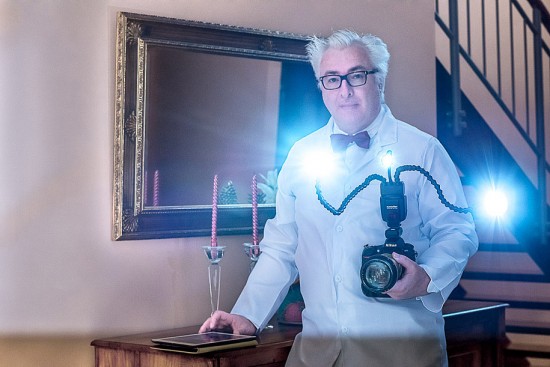
This review of the Venus Optics KX-800 Macro Twin Flash is by Bernhard Sperling:
In early April 2015 the Chinese manufacturer Venus Optics announced the KX-800 Macro Twin Flash. The announcement was also reported in an earlier NR post.
The flash is fitted with three flexible arms, of which two carry each a flash tube unit and one shorter middle arm carries a led permanent light. The flash is manual mode only. The manufacturer claims the following features:
• GN 190 (in feet at ISO 100), GN 58 in meter
• Rapid recycle time (approx. 2-5 seconds)
• 48cm long dual flexible arms
• Independent output control
• LED focus assist light
• Weight: 1 pound
• Compatible with Canon/Nikon/Sony A/Pentax cameras
KX-800 and KR-800
I was immediately intrigued. The main selling point is clearly the ability to position the lights with some more flexibility than traditional macro twin or ring flash units. One could have a proper main and fill light in a portable set. I decided to order the new KX-800 and to give it a try. The order process on the Venus website was uncomplicated and the delivery of the parcel from China to my desk was quite fast, BUT and that is a BIG, BIG BUT the flash that arrived was unfortunately not what I ordered but a flash called KR-800.
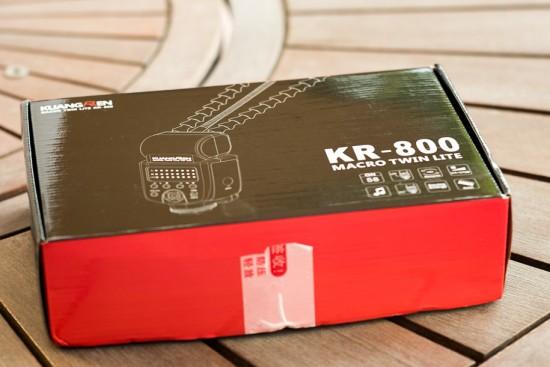
The website of Venus has a note that initially the KX-800 flash will sent out in KR-800 boxes and with a KR-800 manual. The manufacturer explains that they want to use up surplus stocks of old boxes and manuals for the previous model. They state that the new model has better flash arms, but is otherwise unchanged in function.
HOWEVER My flash unit has clearly KR-800 printed on it, so I did not only get the surplus package but also the surplus stock of the old model!
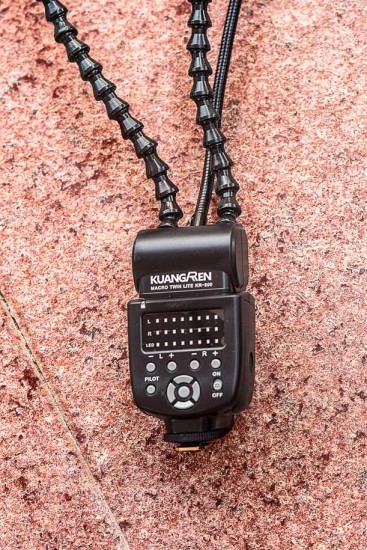
I exchanged a couple of e-mails with the customer service of Venus, and they insist that I have the “NEW” model. After pointing out that my flash clearly spells out the OLD name. They said that they also used some old housings. (Which they did forget to mention on their website.) But it would “really” “honestly” be the new model.
To summarize:
1) I ordered a KX-800 received an order confirmation and receipt for a KX-800
2) I got a flash that spells out KR-800 in a box that says KR-800 and a manual that says KR-800.
3) But and the customer service insists that it “is” a KX-800.
Hmmmmmmmmmmmmmmmmmmmmmmmm???????
So I will review the KR-800 that you might receive when currently ordering a KX-800.
Part 1: The Features of the K(X)R-800
48cm long dual flexible arms
This is the main feature setting the flash apart from all other units on the market. The arms allow to position the lights and have a mini photo studio with you in a portable unit.
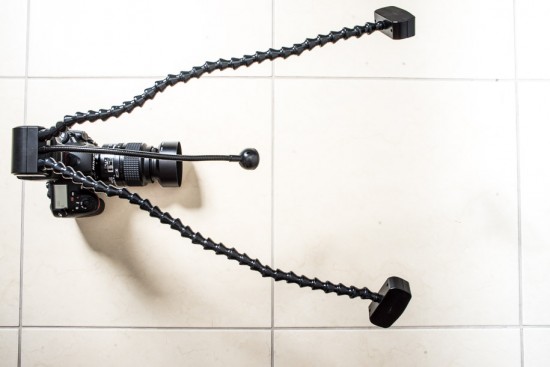
As you can see the lights are way in front of a 105 Macro lens and there is quite a lot of space to move them around. You might even use one as a backlight.
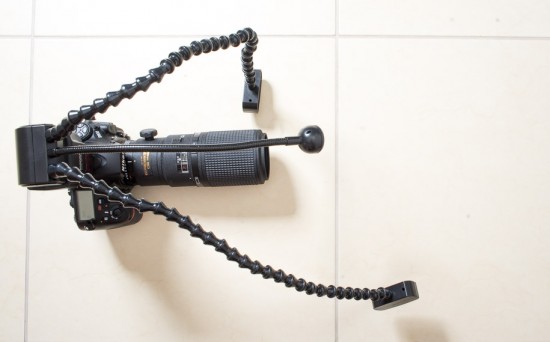
Even with the longest Nikon macro lens the Nikkor 200 4 it is possible to use one arm as fill light next to he lens and one as directional light.
The largest Macro set up I have used is the Pentax 645D with the Pentax 67 135 macro lens and additional helicoid. And the arms are also long enough for this set up. All of the butterfly pictures below are taken with this combination:
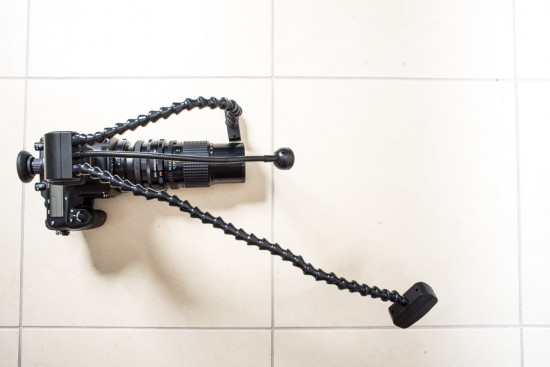
Compare this to the typical macro flash configuration and the difference is obvious by just looking at it. For example here is the Nikon RC1 macro flash set:
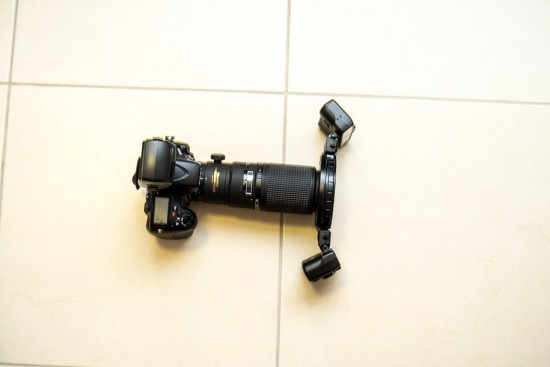
A typical macro flash will always give very frontal light. The next picture is an example with both flash units directly placed left and right from the lens to emulate the typical frontal light:

The light is flat, reflection in the front leaves is not pleasing for me and the leaves in the background get hit by the flash. In the next picture one arm has been positioned above and one from the side in a way so that little light hits the background.

That simple example shows the main feature of the flash. directional light on the go. More texture and structure in the main motive and better separation from the background.
GN 190 (in feet at ISO 100), GN 58 in meter
I have tested the flash unit with a medium grey felt fabric and then again against a white sheet. The flash lights are exactly 2 m placed from the target. I used two methods to evaluate the guide number. First I used a Gossen Mastersix Flash Meter, second I shot a row of pictures with different apertures.
The two test set ups are shown below:
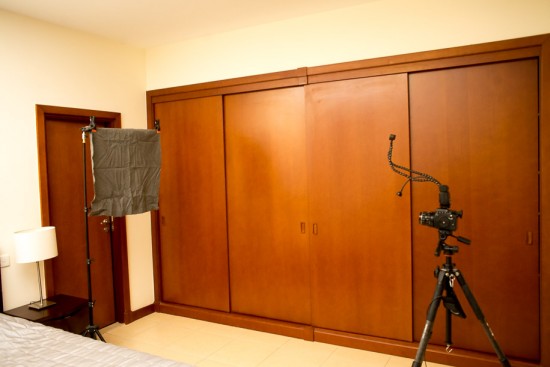
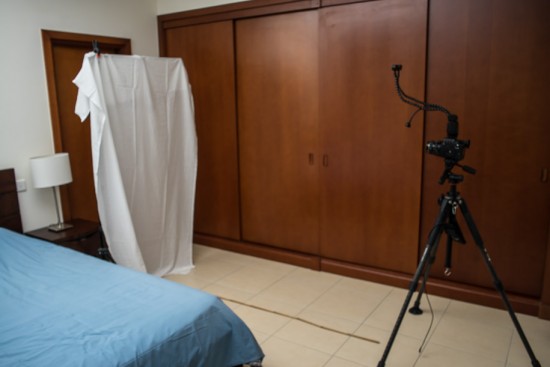
This is not meant to be in any way a “scientific” or “norm” test. Both set ups are probably giving results that are a bit too kind to the flash as there is reflectance from the back wall. The white sheet is anyway 1 to 1,5 stops better. A real norm measurement should be taken from a 21% grey wall.
Test setup 1 measured 11 and 8/10 so rounded up to 16:
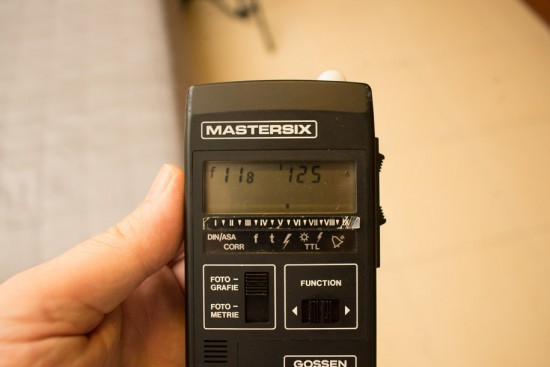
That means at 2m distance and ISO 100 a Guide number of 32!!!! I do not want to bore you with test shots from a grey cloth but to my eyes the aperture 11 were the best ones from the test shots I took. That would be a Guide Number of 22!!!! That was so far off the manufacturers claim that I tested the batteries but they showed 1,58 Volt each. This large discrepancy lead me to make the white sheet test.
The second setup measured exactly 22. So one step more reflectance as expected.
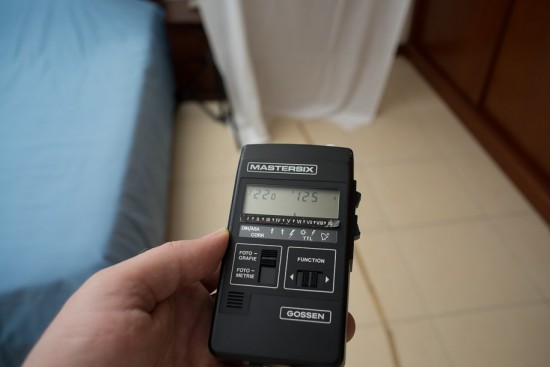
Bottom line is, that even when bending the test conditions as much as I can into the favor of the flash the largest Guide Number I can ever measure at ISO 100 is 44. And the realistic guide number is somewhere between 22 and 32.
I do not know how the manufacturer measured or calculated the GN, but the units delivered to customers deliver around half of what was promised.
Rapid Recycle Time (approx. 2-5 seconds)
With full power on both arms the recycle time is a minimum of 5 seconds and gets longer as the battery looses power. With less than a 1/4 power set recycling is a small delay but it feels fast enough. The values are to be expected and I am OK with it in practice.
Independent Output Control
The output from both flashes and the LED can be independently set in 8 settings from full power to 1/128th. However herein lies also another drawback of the flash: It can only be set in full aperture steps. no half steps no thirds. Being able to set the flash output in third stops has been long established as industry norm.
LED focus assist light
Great for macro work. When extension is used, or you shoot with old manual focus lenses in pre-set aperture mode, the finder can become very dim. The focus assist light is a welcome help in macro mode to be able to focus. It is bright enough over short distances to brighten up the dimmest viewfinder. It is clearly more useful for static objects where precise focusing is possible. Insects on the run might be startled by it. On one hand it might make people squint the eyes in portraits. However if you can avoid the squinting it could be used to keep the pupils small, reducing a possible red eye effect, and making the subject’s eyes wonderfully large. The LED can be set in 8 brightness settings. I am very happy to have this option and I can only recommend to ALL macro flash manufacturers to include a focus help LED into their products. (The Nikon RC1 units have a focus light LED as well)
Light Weight (Weigh 1 pound)
I found the unit indeed quite reasonable to handle. Admittedly I used the flash on bigger and heavier cameras, but I never had the feeling that it starts to unbalance the camera/lens combination, even when the arms are extended forward or sideways. Obviously when the arms are extended you might get entangled in dense undergrowth.
Compatible with Canon/ Nikon / Sony A /Pentax Cameras
The marketing text is a bit misleading. The flash works on a fully manual with all cameras, as long as you can find a way to sync it. It offers a standard hot shoe and a PC connector.
It does not offer any TTL, High Speed Sync, or any other advanced features. It does not have any sensors and it does not offer automatic mode. It does also not have any onboard functionality to work as slave. (Again that is not surprising for a unit that is mainly intended to be used in the hot shoe.) The manufacturers claim is half right in that you can certainly use the flash with the mentioned brands. It is slightly misleading as “compatible” usually implies that some of the advanced flash technology offered by these brands can be used. That is not the case.
Additional Remark
The manual is in Chinese only. But as the flash offers only very basic functionality it is not too difficult to figure most things out.
Part 2: Taking Pictures with it
I used the flash most of the time in main/fill combination seen above. One light far out to give direction and one near the lens to give fill. The fill light was between 1 and 3 stops lower than the main light depending on how pronounced I wanted the shadows to be.
The main advantage is that one can have nice directional light in a mobile unit. The first “model” was a small jumping spider that decided to run over my coffee table just when I started to play with the flash.


Next were the obligatory flowers in my backyard:


And then I headed to the nearby butterfly garden:
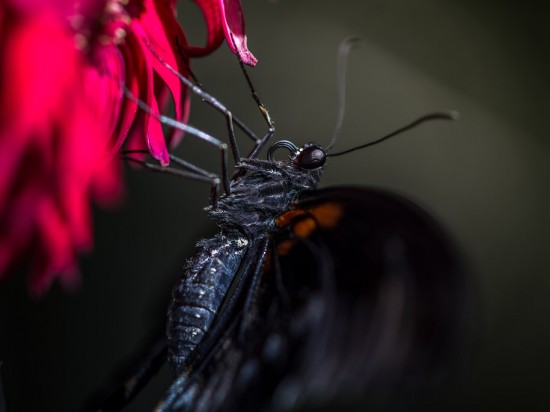
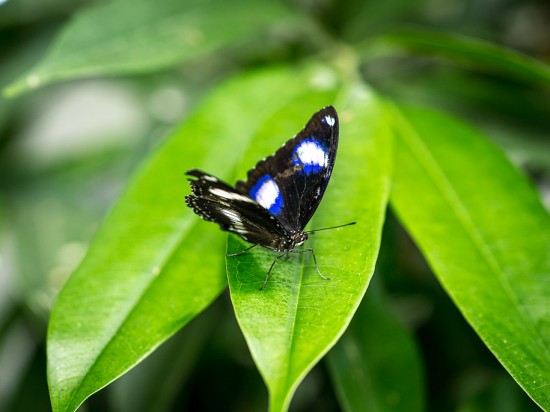
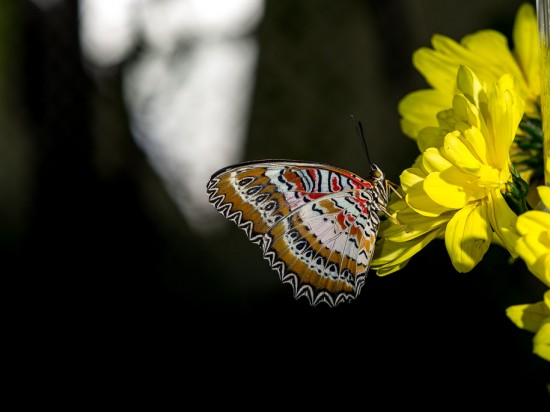
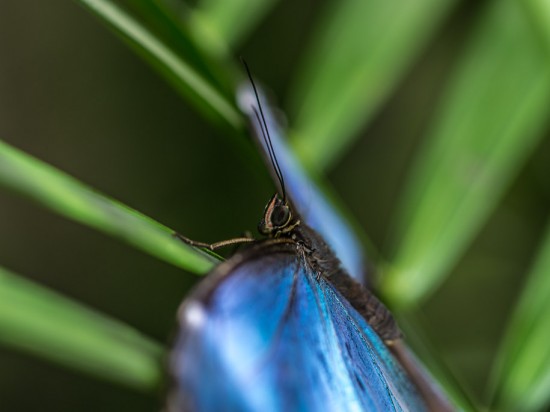
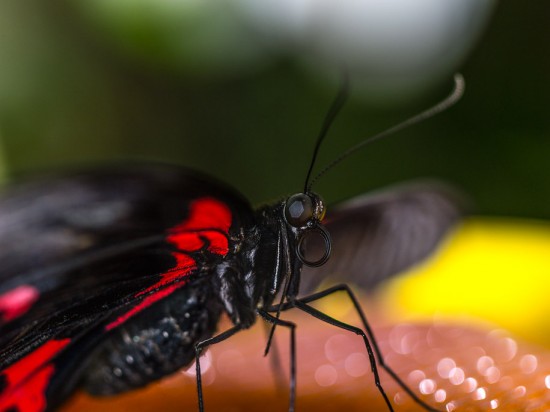
I loved the possibility to position the light. If you watch the butterfly pictures closely you see immediately what I mean. The are no signs of the usual issues that conventional macro flashes have: No washed out nearer elements (first, fourth and fifth) and frontal fill can be controlled. Also having the light more directional rather than full on helps in bringing out texture like in the third picture.
Moving the arms of the flash around is a bit stiff and feels like it needs some force. it does not really work well when you hold the camera up. you need to take it down. and grab the flash and the arm with both hands. Also I had a couple of misfires because by moving the arms around I wiggled the flash main unit and it had slipped a bit out of the flash foot. I guess it might be really difficult and expensive to construct flash arms that are stiff (and stay in position) and are smooth to move.
Most of all I missed TTL. Moving the arms around and varying colors of leaves and flowers needs constant (estimated) correction of flash output. And some chimping. None of the pictures above were the first shot. Well fed butterflies on their digestive nap are patient models. Jumping spiders looking for food are not.
In the meantime many Chinese Manufacturers offer normal flash units with dedicated TTL for around the same price. If TTL is beyond the engineering capacity, at least give us automatic by attaching the sensor to the middle LED arm. Or even cooler give us a macro sensor on a fourth arm. Plastic and electronic components are pennies these days.
Initially I intended to explore the portrait capabilities a bit deeper. But I have not yet found the time. One quick snap below:

Again the same direction and fill configuration like for most of the macro pictures. It works quite well for me. The fill determines the depth of the shadows and the directional light has some nice punch and gives catch lights in the eyes.
As an additional bonus the whole camera and flash combination looks so strange that you might get a good range of expressions out of your talent.
Part 3: Compared to…
The obvious contender is the Nikon RC1 set. Here is a picture from some coins with the RC1:

I know with a bit of effort and by positioning the lights individually you can get a much better picture. But I wanted to have the quick and dirty result with just the two lights attached left and right.
And here are the pictures with The Macro Twin Flash:



You can see the nice variations possible. I like the middle one best. Of course for a subject like coins on a table you could also move the individual lights from the Nikon set around. You would need two additional mini tripods or stands you end up with three things to hold and or move. The advantage of the KR-800 is that you can hold it with two hands.
A real alternative would be to build a DIY custom bracket with gorilla or flexible arms. attach the Nikon lights. That would give you TTL back.
Conclusion
The overall conclusion has good bad and ugly.
To start with Ugly: The clearly misleading marketing hype leaves a bit of a bad taste behind. The flash is in reality much weaker than the touted Guide Number and I could not see any evidence that there is in fact a new model. It is also not compatible with any TTL system and does not even have a simple automatic. The parts and components used are not really expensive and it seems quite a bit overpriced for what it is.
The Bad: It seems to gobble up batteries much faster than other flash units I used. The internal electronics do not seem to make a good job in preserving the unused charge energy. (Again cheaply made.) The handling can be a bit awkward in being fully manual. The repositioning of the flexible arms could be smoother, which would make it possible to move them without taking the camera down.
The Good: It is in fact the only macro flash allowing to reposition the lights with greater freedom in a mobile unit. (Apart from DIY solutions.) I have to admit that I enjoyed macro shots with it. And I will keep mine.
As long as you really need a mobile unit allowing for directional light, and the asking “introductory” price of USD 279 (for the previous model surplus stock) is no biggie for you, go ahead and order one.
For static set-up and table top there is greater freedom of movement in the fully independent units of the R1C1 kit or any cheap strobist solution of your choice. Even a cheap LED solution might be sufficient.
If you own a Nikon R1 or R1C1 kit, you might be better off by getting two flexible arms plus some DIY to have the best of both worlds plus TTL.
This concludes my first impressions, I hope It gave you a good idea what this flash unit is about. I will further explore the portrait capability. A slightly expanded version of this review including the boring pictures of grey and white cloth and further portrait test will be soon on my personal blog at strobeex.blogspot.ae.
If you have an interesting idea for a guest post, you can contact me here.






